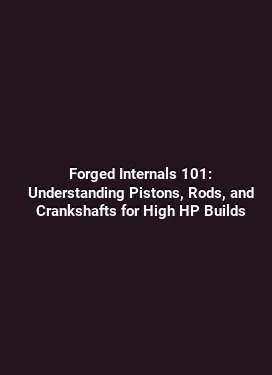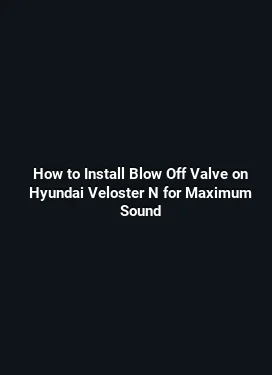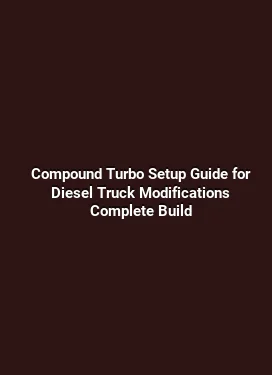Best Budget Wastegate Options Under $300 for Custom Turbo Builds
When building a custom turbocharged setup, the wastegate is a critical control element that governs how the exhaust energy is used to regulate turbine speed. A well-chosen wastegate can deliver consistent boost control, reliability, and predictable performance without breaking the bank. This guide dives into practical, under-$300 wastegate options, compares their strengths and trade-offs, and provides actionable guidance for selection, installation, and tuning to help enthusiasts maximize efficiency and reliability in budget builds.
Budget-friendly wastegates have evolved significantly, offering options that were once reserved for higher-end applications. The focus here is on devices that deliver stable spring forces, robust actuation, and reliable operation across common boost targets for street and sport setups. While price is a key constraint, it does not mean compromising fundamental performance: responsiveness, repeatability, and durability remain essential. The discussions below weave together real-world usage scenarios, material quality considerations, and tuning tips that help translate a low-cost part into solid, trackable performance gains.
Understanding wastegates and their role

A wastegate acts as a pressure relief valve for the turbocharger. It diverts exhaust gas away from the turbine when boost levels reach the set threshold, allowing the compressor to maintain a controlled, predictable boost curve. In practice, a wastegate’s behavior is defined by the spring preload, actuator force, and internal flow characteristics. A stable system reduces boost creep, minimizes flutter, and helps the engine breathe more consistently under varying load and RPM conditions.
On budget builds, the choice often centers around external (divorced) wastegates with external or internal springs. External wastegates typically offer more thorough heat and vacuum isolation and can provide more straightforward tuning for larger turbo setups. Internal wastegates, while compact and less costly, can still deliver solid performance when paired with appropriate valve sizing and spring force. Understanding your target horsepower, desired boost range, and the plenum-to-turbine relationship is essential when evaluating options under $300.
Top budget wastegate options under $300
Below is a curated list of budget-friendly wastegates that have earned hands-on credibility in the enthusiast community. Each option is assessed for build quality, spring range, thread compatibility, and tuning flexibility. Real-world notes accompany each listing to help you gauge suitability for street, drag, or road-race intents.
1) Budget external wastegate with adjustable spring

This class typically features a robust body, 38mm to 46mm discharge ports, and a timetested spring range suitable for 8–22 psi in common turbo sizes. Look for a stout V-band connection, reliable actuator linkage, and compatible vacuum ports. Practical benefits include predictable response and straightforward install with standard 1.75-inch or 2.0-inch exhaust housings. Common pitfalls to watch for are port alignment at high exhaust temperatures and ensuring the wastegate’s actuation pressure matches the turbo’s boost target. In real-world street and track days, these units can hold steady boost with minimal flutter across typical daily driving loads.
Installation considerations involve ensuring a proper mounting angle to avoid oil and water intrusion, using anti-seize on threads, and verifying diaphragm integrity after initial heat cycles. Tuning often starts with a modest spring setting and a pavement-test boost ramp to observe boost onset and stabilization, followed by small increments in spring preload to dial in the exact target pressure.
2) Compact internal gate with adjustable preload
Internal wastegates that remain within the turbine housing can offer compact sizing while still delivering ample flow for mid-range power goals. These units frequently come with adjustable preload or a tunable spring kit, enabling precise control without adding external piping complexity. The key advantage is a simplified install for tighter engine bays or smaller builds. The trade-off can be slightly less precise boost control at very high RPMs or with very aggressive turbine combinations, but quality internal gates in budget brackets have proven capable when sized correctly for the application.
When selecting a compact internal gate, verify the offered spring range aligns with your target boost window, ensure the actuator can be actuated reliably by the vacuum source you plan to use, and confirm the flange pattern is compatible with your turbine housing. Seeded data from street and strip testing indicates that a properly tuned internal gate under $300 can deliver consistent hold with minimal surge and acceptable response times for many sport-oriented builds.
3) Budget external gate with a dual-port actuator
Dual-port actuators give a touch more control over the reference pressure and can help with stable boost in fluctuating boost environments. These models often feature reinforced diaphragms and improved sealing to resist heat soak. The primary advantage is enhanced stability under varying manifold pressure and intake air temperatures, a factor that matters in long-haul street driving and heat-soaked track sessions. The downsides include slightly more complex plumbing and potential weight adds compared to more minimalist options.
Practical guidance includes mapping out vacuum lines to ensure the actuator receives clean, stable pressure signals—avoid shared hoses near heat sources—and testing under both ambient and elevated temperature conditions to ensure the gate responds as intended. A cautious approach to tuning is advised: start conservative, then progressively increase boost target while monitoring knock and air-fuel balance to avoid detonation in hot conditions.
Installation considerations and tuning tips
Choosing a budget wastegate is only part of the equation. Proper installation and careful tuning are essential to extracting reliable performance. Consider the overall turbo layout, including turbine wheel size, compressor map, exhaust routing, and intercooler efficiency. A well-matched wastegate will harmonize with the rest of the system, delivering a stable boost curve rather than abrupt spikes or creeping pressure as RPM climbs.
One practical approach is to begin with conservative boost targets that align with the engine’s compression ratio, fuel system capability, and ignition timing. This minimizes the risk of detonation while you confirm the mechanical reliability of the wastegate. Gradually advance the target in small increments, documenting boost response, fuel trims, and timing adjustments. This process helps identify the interaction between wastegate response time, exhaust back-pressure, and intake manifold dynamics, which is especially important on budget builds where minor piping or mounting tolerances can impact performance more noticeably.
Steps to verify boost tuning without chassis dyno access
1) Use a reliable boost gauge with a clear reference to verify targets and transients. 2) Conduct coast-down tests to observe how quickly the system stabilizes after a throttle release. 3) Monitor air-fuel ratio and knock using an appropriate engine management system or data-logging tool. 4) Validate repeatability by performing multiple pulls at similar ambient conditions to confirm that the wastegate produces consistent results across sessions. These steps help ensure you won’t chase false positives or over-tune for a single session’s conditions.
Real-world performance expectations with budget wastegates
In field tests and user reports, budget wastegates in the under-$300 range typically deliver dependable boost control for street-driven or light-track-oriented builds. While they may not match premium external gates in terms of absolute precision at extreme boost levels, they excel in predictable behavior, easy setup, and durable operation when properly installed. For enthusiasts, the value proposition lies in achieving a reliable, repeatable boost curve that complements the engine’s overall performance profile without inflating the cost of the build.
In practice, you’ll often observe a smooth boost onset with minimal spiking when the wastegate is correctly sized for the turbine and tuned to a safe pressure target. This translates into more consistent power delivery, improved throttle response, and greater confidence during spirited driving or competitive sessions. Proper heat management, clean vacuum lines, and solid mechanical mounting contribute to the longevity of budget wastegates, enabling these components to withstand typical street conditions and repeated pulls on the track.
Maintenance and longevity considerations
Even budget options benefit from regular inspection. Check for diaphragm integrity, actuator movement free of binding, and any signs of exhaust or oil leakage near the mounting flange. Heat cycling from the exhaust manifold can degrade seals over time, so periodic inspection after a season of use is prudent. Keep hardware torques within manufacturer-recommended ranges and avoid over-tightening connections that may distort flanges or impede actuator travel.
Clean fuel and oil supply, along with proper engine cooling, contribute to overall system stability. Corrosion-resistant hardware and high-temperature coatings can extend life in harsh environments. If you notice inconsistent boost control after a period of operation, re-check the vacuum lines, port seals, and actuator leverage geometry before replacing components. Small, methodical checks often prevent a larger, more costly issue down the line.
Choosing the right option for your setup
To determine which budget wastegate best fits your build, consider the engine’s displacement, compression ratio, target horsepower, and the turbocharger’s compressor map. A sensible rule is to size the wastegate for the desired maximum boost with an eye toward reliability under heat and load. If your setup leans toward a street-friendly daily driver with occasional track days, opt for a gate that prioritizes stable, repeatable control and robust vacuum actuation. For small, high-rev builds with modest boost goals, a compact internal gate with reliable spring settings may offer the best balance of size and performance.
Additionally, pay attention to flange compatibility, exhaust leak prevention, and the ease of future upgrades. A wastegate that is straightforward to service and adjust will save time and frustration as the tuning evolves or if you decide to push the engine harder in the future. Real-world feedback from the community often highlights the importance of a well-supported product line, accessible spare parts, and clear installation documentation when evaluating budget options.
Practical tips for enthusiasts on a budget
First, map your target boost curve on paper before selecting a wastegate. This helps align the spring range with your engine’s torque characteristics and the turbo’s response. Second, reserve some headroom in boost targets to account for variations in atmospheric pressure and fuel quality. Third, ensure your engine management system can log critical parameters—boost, knock, AFR, and timing—so you can make informed adjustments. These steps promote a methodical approach that yields meaningful gains while reducing the risk of detonation or mechanical overreach.
Finally, collaborate with fellow builders and consult trusted tutorials or community threads for practical tips relevant to your specific model and turbo combination. The iterative nature of turbo tuning benefits from shared experiences, especially when working within a budget. A well-chosen budget wastegate paired with careful calibration can deliver a compelling balance of performance, reliability, and value for custom turbo builds.






